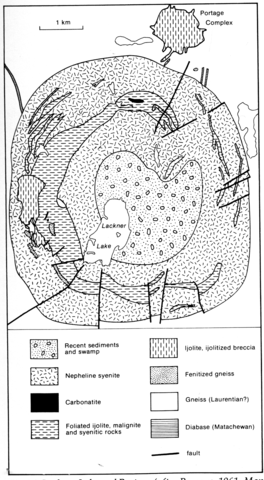stripes
The complex forms a ring of hills rising some 60-70 m around a central basin with little outcrop to the northeast of Lackner Lake. It is circular in plan and 5-6 km in diameter. The Portage complex is an isolated mass 1 km in diameter lying to the northeast. The surrounding Precambrian quartzofeldspathic gneisses have also been located, by drilling, as screens within nepheline syenites. Fenitization leads to the development of aegirine-augite, riebeckite, biotite and calcite. The alkaline complex comprises a series of rings of nepheline syenite but ijolite/malignite rings are discontinuous, apparently having been truncated by nepheline syenite. They grade from melanocratic aegirine-augite-nepheline types to leucocratic feldspar-rich types. Complex xenolithic structures are apparent and zones rich in melanite, wollastonite, magnetite and apatite occur. Fayalite is present in some malignites and Watkinson (1973) has described K-rich malignites containing polygonal pseudoleucites. Dykes of sovitic carbonatite cut these rocks and generate biotite selvages along the walls and around xenoliths. The nepheline syenites are texturally variable and contain perthite and nepheline, generally in about equal proportions, aegirine-augite, sometimes rimmed by amphibole, and biotite with accessory cancrinite, zeolite, fluorite, calcite and pyrochlore. Outward-dipping mafic dykes cut the complex and surrounding gneisses, and contain major pyroxene, biotite, feldspar and calcite with occasional olivine. Extensive drilling has proved the Portage complex to consist of ijolite, which has caused minor alteration to the country rocks. The oxygen isotopic composition of carbonatite is given by Deines and Gold (1973, p. 1720). Rock analyses, modes and photomicrographs will be found in Hodder (1961).
- BELL, K. and BLENKINSOP, J. 1980. Grant 42 ages and initial 87Sr-86Sr ratios from alkalic complexes of Ontario. Miscellaneous Paper, Ontario Geological Survey, 93: 16-23.
- Deines and Gold, 1973;
- Hodder, 1961;
- Lowdon et al., 1963;
- Owen and Faure, 1977;
- PARSONS, G.E. 1961. Niobium-bearing complexes east of Lake Superior. Geological Report, Ontario Department of Mines, 3: 1-73.
- WATKINSON, D.H. 1973. Pseudoleucite from plutonic alkalic rock-carbonatite complexes. Canadian Mineralogist, 12: 129-34.

